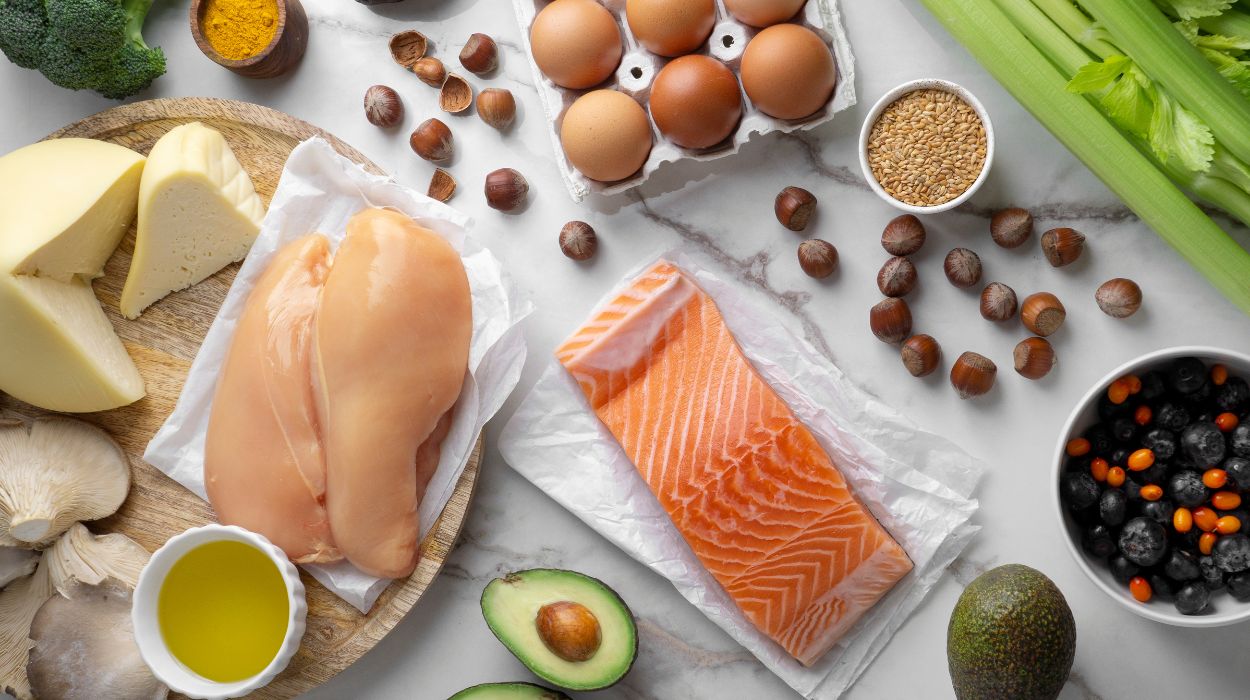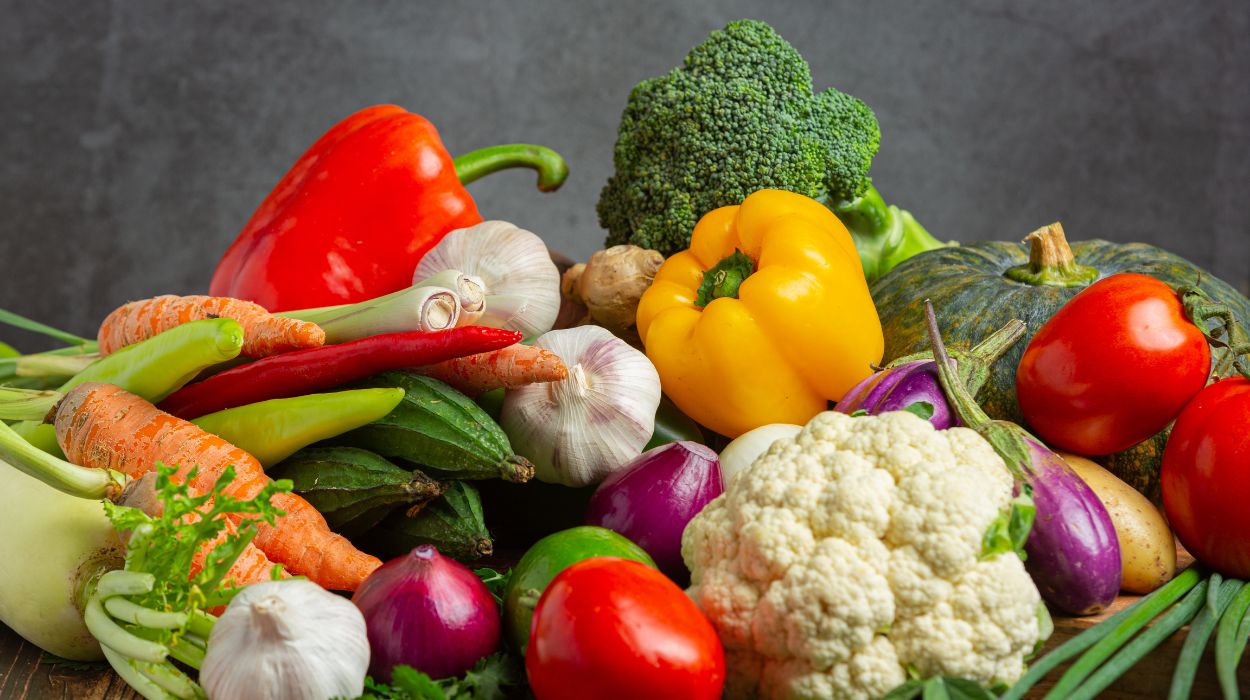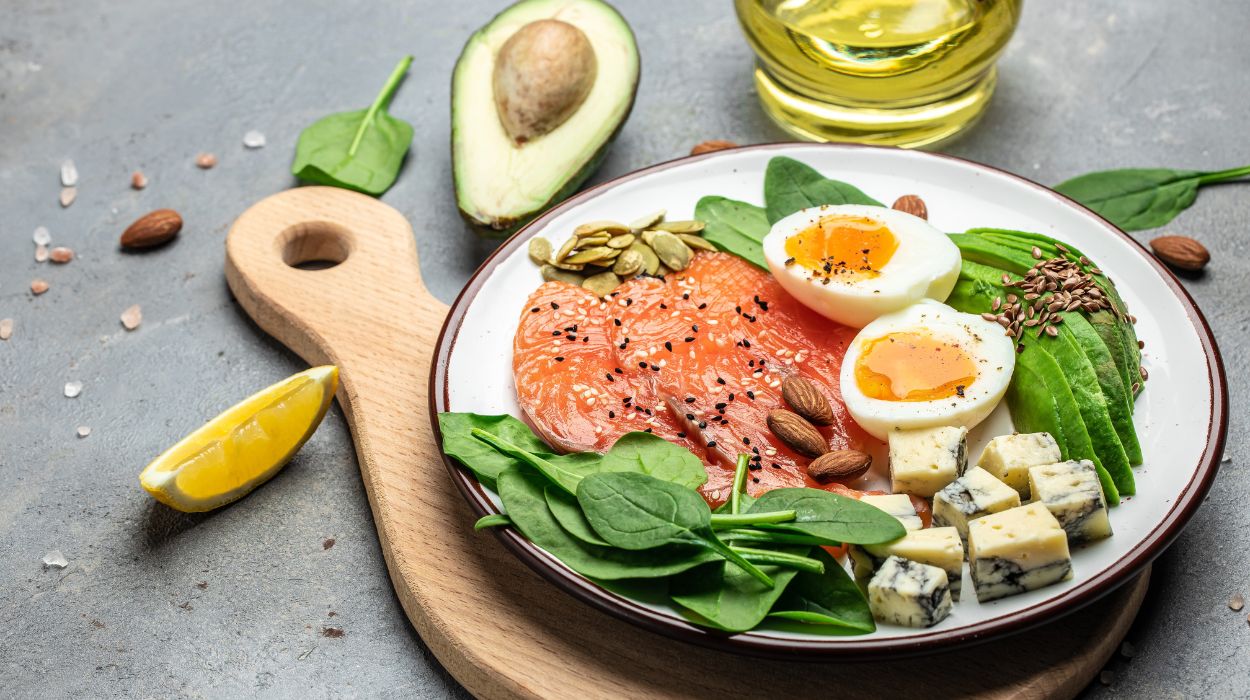Are you looking for a sustainable and health-conscious approach to weight loss? Low-carb diets have emerged as a viable solution to shedding unwanted pounds.
Low carbohydrate diets are often touted for their weight management properties. But just how much substance do these ‘rumors’ hold?
If you’ve been considering low-carb foods for weight loss, join us as we explore the power of nutritious, low-carb ingredients to steer you toward your desired fitness goals. From crunchy veggies to lip-smacking proteins and weight-loss smoothies, we’ve curated a powerhouse list of low-carb foods for your meal plans.
Say goodbye to fad diets and quick fixes that promise to shift the scale but often fall short on results—and hello to a waist-friendly diet that’s loaded with beneficial, tasty choices. Revitalize your diet to a slimmer you with these powerful low-carb foods for weight loss.
Low-Carb Foods List For Weight Loss
- Lean meats — Chicken, turkey, fish, and seafood.
- Dairy — Greek yogurt and cheese.
- Tofu and tempeh.
- Eggs.
- Leafy greens — Spinach, kale, and lettuce.
- Cruciferous vegetables — Broccoli, cauliflower, and Brussels sprouts.
- Healthy fats and oils — Canola oil, peanut oil, avocados, pumpkin seeds, peanut butter, salmon oil, and coconut oil.
- Low-carb fruits — Berries, avocados, lemons, limes, and watermelon.
- Nuts and seeds.
- Carb-free drinks — Water, coffee, herbal teas, kombucha.
- Low-carb dressings — Apple cider vinegar and olive oil.
- Spices and herbs — Basil, ginger, and cinnamon.
- Dark chocolate.
8 Low-Carb Foods For Weight Loss
When it comes to shedding those extra pounds, low-carb foods emerge as your ultimate ally. These nutrient-packed delights aid weight loss and keep you energized and satisfied.
Here are the best low-carb foods for weight loss:
Protein-Rich Foods

Several clinical studies[1] have established protein as a vital player in weight management. Besides being essential building blocks for your body, protein boosts your metabolism, helping your body burn more calories.
A higher protein diet that contains 30% of your calories from protein also curbs hunger by increasing the feeling of fullness and reducing overall calorie intake.
Here are excellent examples of high-protein, low-carb foods for weight loss:
- Lean meats: Lean cuts of chicken, beef, pork, lamb, and seafood are good sources. They offer a flavorful way to meet your protein needs while keeping carb intake in check. Fish, particularly the fatty kind like salmon, also offer a bonus with their heart-healthy omega-3 fatty acids.
- Eggs: Versatile and nutrient-rich, eggs are a go-to option for high-quality protein. Whether scrambled, poached, or incorporated into different recipes, they make a great addition to your low-carb diet.
- Dairy products: Cheese, plain Greek yogurt, and milk provide protein and essential nutrients. A 2016 meta-analysis of randomized controlled trials[2] indicates that increasing dairy intake as part of an energy-restricted diet reduces body fat mass. However, be mindful of the carb content, especially in flavored or sweetened dairy products.
- Tofu and tempeh: If you’re following a vegetarian or vegan low-carb diet, tofu and tempeh provide substantial protein without the high-carb content found in some other plant-based options.
Vegetables

Many vegetables are nutrient-dense, low-carb options high in fiber and essential nutrients. They promote satiety, ensuring you feel full and satisfied, thus reducing energy intake. A research team in 2018[3] found that children who ate vegetables before meat or fish were less likely to develop childhood obesity.
Low-carb vegetables fall into two categories: Leafy greens and non-starchy vegetables.
Leafy Greens
- Spinach: A staple in salads, omelets, and smoothies, spinach is a nutritional dynamo. It’s low in carbs and packed with vitamins.
- Kale: Kale has earned its reputation as a superfood[4] low in carbs and rich in vitamins such as vitamins K and C.
- Lettuce: Lettuce varieties like iceberg and romaine provide a refreshing and low-carb base for salads and wraps.
Non-Starchy Vegetables
- Broccoli: With its mild flavor and firm texture, this cruciferous vegetable is known for its low-carb and high-fiber content.
- Cauliflower: Cauliflower has gained fame in the low-carb world for its adaptability.
- Asparagus: Asparagus offers a delightful combination of tenderness and flavor.
- Cucumbers: Refreshing and crisp, cucumbers are perfect for snacking and adding a refreshing crunch to your salads.
- Bell peppers: Bell peppers come in various vibrant colors, are low in carbs, and high in vitamins. They can be stuffed, sautéed, or enjoyed as a crunchy snack.
- Zucchini: Zucchini’s mild flavor and versatile nature make it a fantastic low-carb substitute for pasta or a canvas for stuffing, grilling, or roasting.
- Brussels sprouts: Known for their distinctive taste, these non-starchy veggies are low in carbs and high in fiber.
- Carrots: While slightly higher in carbs than some other non-starchy vegetables, carrots are still a relatively low-carb option.
Healthy Fats
Regimens high in healthy fats, like the Nordic diet[5] and Mediterranean diet,[6] promote weight loss and maintenance by supporting satiety and nutrient absorption.
Good-for-you fats include:
- Monounsaturated fats: Olive oil, canola oil, peanut oil, avocados, pumpkin seeds, and peanut butter.
- Polyunsaturated fats: Omega-3 and omega-6 are polyunsaturated fats essential to your body. Sources of polyunsaturated fats are sunflower oil and seeds, soybeans, walnuts, tofu, and cold-water oily fish like salmon, sardines, anchovies, and herring.
Animal studies[7] have shown a positive effect of consuming omega-3 fatty acids in reducing body fat percentage. Still, more research is required to prove the efficacy of fish oil in obese humans.
Low-Carb Fruits
A 2015 observational study[8] on women with a normal BMI deduced that high fruit intake is associated with a lower risk of obesity. While fruits are generally higher in carbohydrates than vegetables, a few are relatively low in carbohydrates and can still be included in your low-carb diet in moderation.
The anti-obesity mechanisms of fruits[9] include improved satiety, nutrient uptake, and balanced gut microbiota, which help maintain a healthy weight. Good examples of low-carb fruits include:
- Berries: Strawberries, blueberries, and raspberries are rich in antioxidants. They can be enjoyed alone, in yogurt, or as toppings for low-carb desserts.
- Avocado: Avocado is a unique fruit high in healthy fats and low in net carbs. It’s a versatile addition to salads, sandwiches, or simply eaten on its own with a sprinkle of salt and pepper.
- Citrus fruits: Lemons, limes, and grapefruit add zing to your dishes without packing on the carbs. Whether as a refreshing drink or a tangy addition to your recipes, citrus fruits have high water and fiber content[10] that fills you up and prevents you from feeling hungry.
- Watermelon: Surprisingly, watermelon makes the cut as a low-carb fruit option. It’s a hydrating and sweet treat in moderation. Enjoy it sliced or blended into a refreshing smoothie or juice as part of your low-carb journey.
Nuts And Seeds
Nuts and seeds are satisfying snacks that provide healthy fats, protein, and fiber. Even so, they are high in calories and are thus best enjoyed in moderation.
Some great choices include:
- Almonds: A fantastic source of healthy fats and protein, a small handful makes for a satisfying and convenient snack.
- Walnuts: Walnuts are a heart-healthy addition to your diet and are known for their omega-3 fatty acid content. They can be eaten on their own or added to salads.
- Chia seeds: Chia seeds are packed with fiber and can be used in chia pudding, added to smoothies, or sprinkled on top of yogurt.
- Flaxseeds: This fiber-rich option can be ground and added to recipes such as baked goods or as a thickening agent in soups and sauces.
Low-Carb Beverages
Do you know that what you drink also contributes to your caloric intake? Sugary drinks like fizzy sodas and artificial fruit juices significantly impact your calorie and carbohydrate consumption.
These sugar-laden beverages contribute empty calories that thwart your weight loss efforts.
Check out these low-carb beverages you can enjoy without worrying about weight gain:
- Water: Water is the best beverage for a low-carb diet as it has no carbs or calories. Science tells us that increasing water intake suppresses your appetite and boosts your metabolism,[11] facilitating weight loss. Drink water plain, sparkling, or flavored with herbs or fruit slices.
- Unsweetened coffee and tea: Coffee and tea are both low in carbs and high in caffeine. Increased caffeine intake[12] is linked to reductions in body weight.
- Unsweetened milk alternatives: Unsweetened almond and coconut milk are viable alternatives to cow’s milk. They can be enjoyed independently or used in smoothies, coffee, or tea.
- Vegetable juice: Vegetable juice is a good source of vitamins and minerals, but it’s important to choose a juice that is low in carbs. Avoid juices that contain added sugar.
- Kombucha: This fermented tea contains probiotics and beneficial bacteria for gut health.[13] It is also low in carbs and calories and is an excellent choice for rehydrating and recharging your body after workouts. However, more human studies are needed to prove this drink’s efficacy in preventing weight gain.
- Low-carb sports and energy drinks: These drinks help replenish electrolytes and fluids after exercise and are lower in carbs than traditional sports drinks and energy drinks.
- Low-carb alcohol: If you occasionally partake, hard liquor, such as vodka, whiskey, and gin, are carb-free options. There are also low-carb beers and sugar-free wines. However, be mindful of the calories and drink responsibly.
Low-Carb Dressings
When choosing condiments and dressings, select options that are low in carbs and made with healthy fats, such as:
- Vinegar: Apple cider vinegar and balsamic vinegar add flavor to your dishes without adding significant carbs.
- Mayonnaise: Opt for mayonnaise made with healthy oils and minimal added sugars.
- Salad dressings: Choose dressings low in added sugars and made with healthy fats, like olive oil or avocado oil-based dressings.
Notable Mentions
In addition to the previously mentioned foods, several other options can complement your weight loss journey while keeping your carb intake in check. Here are some noteworthy additions:
- Dark chocolate: Dark chocolate with a high cacao content is a satisfying treat with minimal carbs. It regulates blood sugar levels thanks to its high polyphenol and antioxidant content, which minimizes cravings for less nutritious foods.[14]
- Spices and herbs: Enhance flavor without added carbs by incorporating weight-friendly spices and herbs[15] like basil, cardamom, cinnamon, coriander, garlic, ginger, nigella, and turmeric.
They help maintain weight through their contribution to metabolism and blood sugar regulation. This explains the use of spices and herbs in any popular weight loss supplement.
- Nutritional yeast: For a cheesy flavor without the actual cheese, nutritional yeast is an excellent alternative. It contains vitamin B-12, which boosts metabolism,[16] effectively breaking down carbohydrates into energy. Sprinkle it on popcorn or salads, or use it as a seasoning for a savory boost.
Tips For Eating Healthy Low-Carb Foods
If you find yourself wondering, “How many carbs should I have daily?” or “How much fiber should I eat,” check out these tips to support a healthy low-carb lifestyle:
- Find a low-carb diet that fits your lifestyle: There are many different low-carb diets available, so learn how to calculate the net carbs of different foods.
- Plan and prep: Outline your meals and snacks in advance to consume a balance of proteins, healthy fats, and low-carb vegetables.
- Set carb limits: Determine your daily carb limit based on your health goals.
- Prioritize fiber: Choose high-fiber, low-carb vegetables and fruits to add bulk to your meals and promote digestive health.
- Choose whole foods: Opt for whole, unprocessed foods to minimize carb intake and maximize nutritional benefits.
- Increase protein intake: Consume enough protein-rich foods for satiety and muscle maintenance. Aim to get at least 1.2 grams of protein per kilogram of body weight per day.[17]
- Stay well-hydrated: Drink water or other low-carb beverages to support metabolism and control hunger.
- Portion control: Even with low-carb foods, portion control matters. Pay attention to serving sizes to maintain a calorie balance.
- Enjoy healthy fats and oils: Include healthy fats, such as avocados, olive oil, and nuts, to promote satiety and ensure a balanced diet.
- Foods to avoid: Steer clear of refined grains, sugary snacks, and other high-carb foods such as processed foods that contain unhealthy fats and sodium. Read labels diligently to identify potential pitfalls.
- Be patient: Losing weight on a low-carb diet takes time. So, don’t get discouraged if you don’t see results immediately.
Conclusion
Prioritizing low-carb foods for weight loss offers a sustainable approach to achieving and maintaining a healthier weight. You can optimize your diet in 2023 by focusing on nutrient-dense and fiber-rich options.
Embrace the low-carb lifestyle and savor its health benefits to your overall health and well-being.. Your journey to a fitter, more vibrant you starts with the choices you make today.
However, it’s best to consult a healthcare professional before changing your diet. A doctor or registered dietitian will craft a low-carb foods list for weight loss and recommend exercise and lifestyle changes to help you shed unwanted pounds safely and sustainably.
Frequently Asked Questions
If you’re wondering how to lose weight fast on a low-carb diet, reduce carb intake, prioritize protein and healthy fats, and maintain a calorie deficit through balanced, nutrient-dense meals. You should also incorporate regular exercise for optimal results.
A lack of carbs for three days may put the body in ketosis, where the body burns stored fat for energy. However, prolonged carb restriction may impact energy levels, affecting certain bodily functions.
While drastically cutting carbs may lead to short-term weight loss, completely cutting out carbs results in nutrient deficiencies. A balanced approach that emphasizes quality carbs is more sustainable.
The ideal balance depends on individual preferences and health goals. A moderate reduction in both carbs and unhealthy fats while emphasizing high-quality, nutrient-dense sources of carbs and fats is vital.
Daily carb intake for weight loss varies. Generally, staying within 20-50 grams[18] per day can induce ketosis, promoting fat burning.
 Evidence Based
Evidence Based
